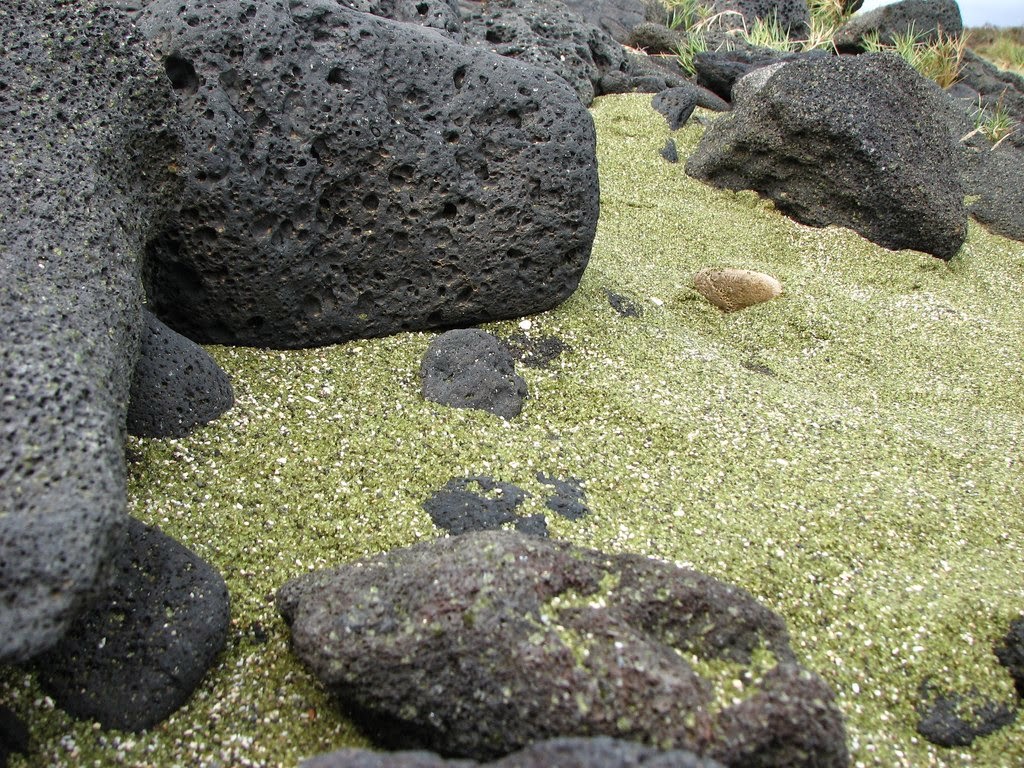This beautiful emerald beach is located in South Point, Ka'u district on the Big Island of Hawaii. The green sand beaches are rare and are only found in the Galapagos Islands or Guam, United States.
The sand is actually a green olive color caused by eruptions from what was once a volcano. In fact, green sand beach itself is within what was once a cinder cone. Three sides of the cone are still present, with the ocean coming in from what would have been the eastern edge.
Imagine swimming in an ancient volcano's cinder cone with green sand? You can and it is a site not to be missed when traveling to the Big Island.
However, getting to this beach isn't easy. Papakolea is located at the base of Pu'u O Mahana, an old littoral cone in a wild, undeveloped terrain. Access involves a three-mile (4.8 km) hike through lava fields. If you're going on a sunny day, keep in mind that it is usually quite windy in this area, which blows up the dust.
It is a good idea to prepare yourself for what some call a long and arduous walk. So wear hiking boots, a T-Shirt, comfortable pants or shorts and a hat and bring plenty of water and sunscreen. It is a common sight to see tourists arrive in sandals and bathing suits who turn around half way because they can't make it.
Also, there aren't any signs, markers or maps to follow. There isn't even a specified trail. A good tip is to stay a little bit more to the left on the way there. Even though the trails near the ocean are nice, they are more rugged with sharp lava rocks and in the end will take longer.
Once you make it to the beach, you'll be rewarded with one of the best views on the Big Island. The green beach appears almost unreal against the backdrop of steep cliffs and boulders.
At sunset, the play of colors against the sand is simply breathtaking. To get down to the beach, you'll have to hike down a low sea cliff. The best spot is the area where the cliff is less steep. The steep face of the cliff is dangerous because the ground is loose and can slide away.
The sparkling blue water appears calm, but beware that currents are often times difficult to spot, so it is best to stay close to the shore if you plan to swim here. If the surf is up, don't go into the ocean because if you get in trouble here, you're miles away from any help. There are no lifeguards on this beach.
Micrograph of the beach sand.
A visit to Papakolea Beach is a full-day trip, so plan ahead. The hike to and from the beach alone takes about 2-3 hours, depending on how fast you can walk, and then you still need to calculate for some time on the beach and the drive time it takes to get to South Point.
It is best to leave the beach well before sunset because as mentioned above, the area is undeveloped, there are no lights and the terrain is rough. It is not a good idea to walk here in the dark.
Directions: Papakolea is located at Mahana Bay, three miles northeast of South Point, the southernmost point in the United States. At the end of the paved South Point Raod to Ka Lae (South Point), take the road to the left.
Park at the end of the road. This is the first parking lot, which is about 3 miles (4.8 km) away from Papakolea Beach (you'll see a portable bathroom here). From here, it takes about 90 minutes to hike down to the beach. About one mile into the hike, there is a second parking lot. To get to it, you have to make a left turn from the main road about ¼ mile (400 m) before the first parking lot.
There are signs that prohibit cars from driving all the way to the beach, which is a very rough and bumpy road. However, local residents frequently drive all the way to the beach with their 4WDs. It is not a good idea to take a rental car on this trail because it's too rough and dusty (and most rental car contracts prohibit driving on unpaved roads).
Also, it is not guaranteed that the trail will be open, even for hikers. Sometimes the gate is closed and while it is easy to walk around it, it probably has a reason why it is closed (high surf, rock slide, etc.), so it is a good idea to find out before walking around it.

.png)






















No hay comentarios:
Publicar un comentario